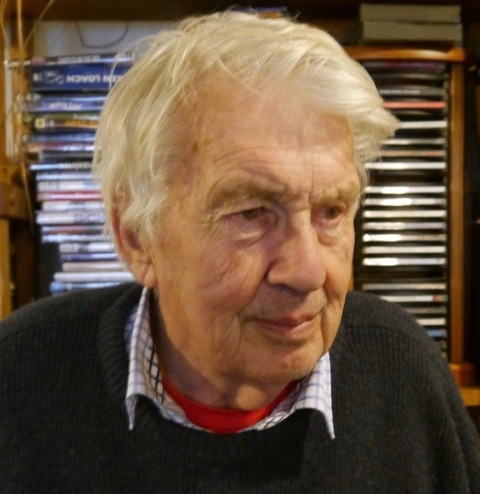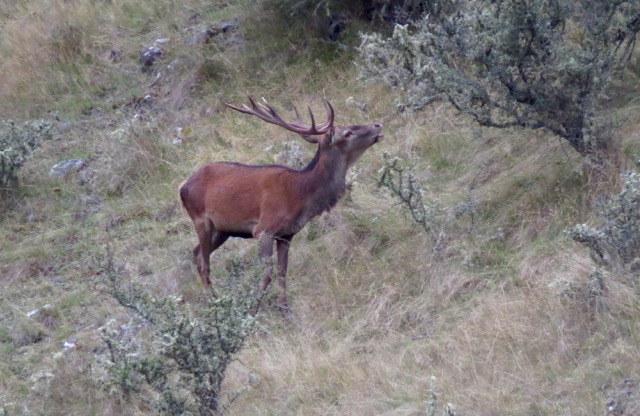By the late Bill Benfield
A reader has sent in this article,written by Wairarapa conservationist and author Bill Benfield and published in “Investigate” magazine February/March 2014. This is an abridged version. It still remains very relevant in 2021 and especially in light of the Department of Conservation currently administering a review of Fish and Game. The review has been described by some critics as a “state grab for control by DOC.”

The late Bill Benfield
For decades New Zealand children have been educated since pre-school to believe that there’s no place for possums or deer in our native forests. Millions upon millions of dollars are spent on pest-eradication each year using toxic 1080 poison which contaminates waterways and kills a huge amount of forest life. But what if this entire conservation policy was based on a lie?
New Zealand has always claimed that its conservation is special because its forest ecosystems evolved without browse or browsers.
New Zealand’s conservation management since the early 1930s sought to eradicate (exotic) browsers. What started as government cullers with service rifles killing deer, has over time morphed into aerial broadcast of attractant baits dosed with the metabolic poison, 1080 (sodium mono-fluoroacetate).
Ecosystem Toxin
Any insect, bird or animal, that requires oxygen as part of its metabolic process is affected. 1080 could be considered a “whole ecosystem poison” and the programme draconian with implications to both rare and endemic wildlife.
In seeking to understand the reasons for such extraordinary conservation management, we have to understand one man’s – Leonard Cockayne – pivotal role in it. Over time Cockayne’s “vision” has become deeply imbedded in New Zealand law and even embraced by the science establishment and is still growing with recent programmes such as “Pest Free NZ”.
English born Leonard Cockayne with a private passion as a collector and gardener of NZ plants, was a school teacher. In 1884 his father died and the patrimony bequeathed him, left him financially independent. He left teaching and established his “unorthodox garden” near Christchurch.
An incredibly prolific writer, he sent seeds and samples to other collectors. This brought him to the note of Professor K von Goebel at Germany’s University of Munich. The two corresponded and in time Cockayne was awarded an honorary PhD. His unearned and honorary qualifications put him out of reach of normal scientific fact-checking and scrutiny.
Zealous self-promotion
With the gift of a PhD, Cockayne with zealous self promotion became the senior scientific figure in botany in the colony. In view of Cockayne’s inability to see his specimens as part of an ecosystem, there is the whole issue of his complete blindness to the evidence that was all around him of the evolutionary origins of New Zealand forests.
For example there was evidence that until comparatively recently, forests must have been inhabited and browsed by substantial numbers of moa.
But Cockayne was in self denial about the browsing by moa. Instead Cockayne had a burning hatred of deer browsing. By the time of the “Deer Menace Conference” in 1930, he was in full voice as the evangelising radical gardener/botanist bearing his “fiery cross” to save his precious forest garden from browse.
By alarmist rhetoric, Leonard Cockayne ensured it would be government policy that all mammalian browsers such as deer, must be eradicated.
That policy still exists today.
Anti-exotic Phobia
It was also at that time, the years 1930 and 1931, that Cockayne was the president of what has become New Zealand’s largest and most powerful conservation organisation, the Royal Forest and Bird Protection Society, a body which in the 21st century, despite all the evidence to the contrary, continues to maintain Cockayne’s anti-exotic-phobia and the claim that the forest was never browsed.
Today with Cockayne’s mantra firmly embedded in government policy and further urged by the Forest and Bird Society, anti-exotic wildlife policies prevail.
In the 1950s the Cockayne mantra was seriously challenged by a young American scientist who joined the Wildlife Service of the Department of Internal Affairs. Thane Riney was put to work on the department’s wild animal eradication operations. He was able to disprove Cockayne’s claim erosion was caused by animal browse.
Riney’s team study on Lake Monk in Fiordland showed that browsers (deer and possum) dd not eat forests to death but their population came to a dynamic equilibrium with time, creating a stable and sustainable relationship with the forest.
Pilloried
Thane Riney’s research caused considerable angst within the Forest Service and he was publicly disparaged by senior officials for his research.
So too was Professor William Graf a US scientist, who was at the time, visiting New Zealand to view the wild deer situation. He described the country’s departmental official as afflicted with an “anti-exotic wild animal phobia.”
A 1981 Canterbury Museum published study of moa gizzards confirmed “beyond doubt that moa were browsing animals that inhabited forest or forest margins.”
In 1989 at a conference, scientist Les Bachelor of Forest Research, estimated on the basis of the production ability of the forest, there must have been between six and twelve million moa. As the land was then substantially forested, they must have been browsing the forest.
Millions of Moa
Probably one of the world’s greater ecologists of the later parts of the 20th century was New Zealander Dr Graeme Caughley. At the same conference as Les Batchelar, he was even more forthright saying forests without browsing, were in an “un-natural state.” He estimated moa numbers at around six million.
Despite the eminence of Dr Caughley the concept of accepting “exotic browse” ultimately had the effect to make the scientific community push its head deeper into the sand.
Attempts to eradicate browsing animals such as deer, using 1080 poison broadcast from the air, began in the 1950s and were on-going with only minor monitoring of the ecological impact.
After the Department of Conservation’s formation in 1987, aerial 1080 operations increased greatly.
To asses the effects of aerial 1080 on forest floor insects, a study was carried out in the early 1990s by entomologist Mike Meads.
Research Killed
He concluded that 1080 poison originally registered as an insecticide, logically did considerable harm to forest floor insects.
However Mike Mead’s study was not what authorities wanted to hear. The departments set out to kill the study.
It was peer reviewed six times and the study was finally buried. The event was a salutary lesson to scientists on the dangers of independence and integrity.
Buttressed by a compliant science and academic community, large and profitable state owned poison factories and state agencies came to see in New Zealand’s “conservation industries”, a continued and comfortable existence. Cockayne’s vision is still entrenched.
In 2011 two research papers on moa confirmed previous gizzard studies showing not only were moa forest browsers, but the material eaten comprised most forest plants such as podocarp and beeches. Diet included fuschia, broadleaf, wineberry as well as plants such as coprosma and forest vines.
Other Browsing Birds
Though the several species of moa were the principal browser, there were many others herbivore birds including the extant kereru (pigeon) and paradise shelduck, the functionally extinct takahe and kakapo as well as many extinct geese and flightless ducks that have been overlooked as herbivores.
Like Cockayne, compliant researchers over-state the impact of wild animal browsing. They ignore that by Landcare Research’s own numbers, the wild deer population population in New Zealand is around 250,000 animals, only a very small fraction of both Batchelar’s and Caughley’s multi-million estimates for moa numbers.
New Zealand’s 250,000 wild deer now perform the browsing function once carried out by millions of moa, – but not if DOC gets it way.
There are no large forest ratites (birds) suitable for New Zealand’s climate and there are only as Dr Caughley proposed, mammals. In the context of New Zealand that would fly in the face of the rigid orthodoxies of “conservation” mantras, primarily that “forests were never browsed”.

Landcare estimates wild deer numbers at a quarter of a million, (250,000) compared scientist estimates of several million moa
Dogma Dominates
The restoration of a complete ecosystem will only remain a dream while such dogma remains.
Present “management” is dogmatically trying to constrain a dynamic system in a frozen state by ecosystem 1080 poisoning.
In fact, 1080 is a metabolic poison that affects any creature that requires oxygen as part of its metabolic process. Although 1080 was originally registered as an insecticide, it kills birds, animals and even the forest insects that work the leaf litter to make soil.
Ecosystems are disrupted by aerial 1080. Generally as shown by research, following 1080 drops, the faster super-breeders like surviving rats recover first and come to dominate the forest. Stoats whose main prey is rats, then explode in numbers. Meanwhile many native birds like kea, are right now being driven to extinction.i
It remains on one hand, Cockayne’s followers like religious zealots, who bearing their “fiery crosses” ignore the massive collateral damage, in pursuit of their greater goal of a frozen in time “eco-purity”.
And on the other hand is the cynical venality of the poison industries which will continue to pursue their profits until they have finally destroyed it all.

Bill Benfield thoroughly researched his material. His books “The Third Wave” and “At War with Nature” reflect his meticulous preparation. It’s is hypocritical for DOC to be wanting to expand its empire by getting on Fish and Game management. DOC cannot manage its duties now and when it does try to, it blunders with ignorance and incompetence, evident as Bill’s view shows.
How does it align its anti-exotic phobia with managing trout fisheries?
Current media censorship ensures alternative voices remain buried
Bill Benfield, Bill Axbey, Mike Meads and so many alive today are the totara of our past and future
As Bertolt Brecht wrote in the David Hare translation of his play ( now on in Auckland) GALILEO …
TRUTH IS THE CHILD OF TIME NOT THE PRISONER OF AUTHORITY
Maybe in the time of our grown mokopuna this ecocide will end
The late Bill Benfield made a big contribution while too many, far too many, stood lamely by. Plato once said “The price of apathy is to be ruled by evil men”.
The Fish and Game review is in line with that I perceive. Wakey! Wakey!
We just don’t seem to have common sense anymore. The poisoning of our world has gone on for too long and has to stop. We have to go back to the 1918 flu which killed 50 million people to see what evil men we have in the world. This was man-made by the Rockefeller Foundation and was injected into US army men who bought it over to Europe and we know the outcome of that. Spanish flu, covid 19 are just names Now we have fluoride which is slowly poisoning us not to mention glyphosate, and now sodium fluoroacetate since the 1950s. It is time we all said enough is enough. Those experienced people who know the bush know better and we don’t want this to go on but while we have the Cabul we have evil people.
After the way DoC has plastered New Zealand’s countryside with 1080 poison, killing native fish and insects as well as inflicting a merciless agonising death on so many harmless animals such as horses, domestic cattle, dogs and deer everyone would of course want them involved in the trout and salmon in our rivers. Yeah, right!